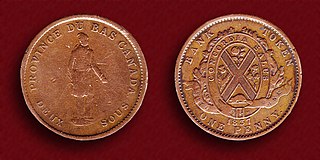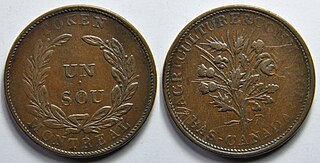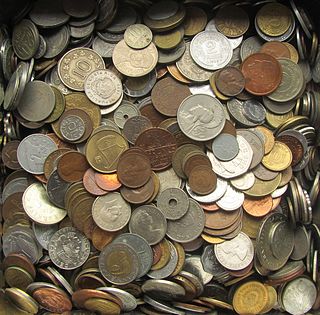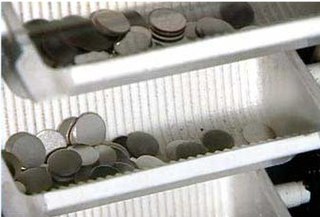
The standard circulating coinage of the United Kingdom is denominated in pounds sterling, and, since the introduction of the two-pound coin in 1994, ranges in value from one penny to two pounds. Since decimalisation, on 15 February 1971, the pound has been divided into 100 (new) pence. From the 16th century until decimalisation, the pound was divided into 20 shillings, each of 12 (old) pence. British coins are minted by the Royal Mint in Llantrisant, Wales. The Royal Mint also commissions the coins' designs.
The history of the penny of Great Britain and the United Kingdom from 1714 to 1901, the period in which the House of Hanover reigned, saw the transformation of the penny from a little-used small silver coin to the bronze piece recognisable to modern-day Britons. All bear the portrait of the monarch on the obverse; copper and bronze pennies have a depiction of Britannia, the female personification of Britain, on the reverse.

The British penny, a large, pre-decimal coin continuing the series of pennies that began about the year 700, was struck intermittently during the 20th century until its withdrawal after 1970. Throughout the period 1901 to 1970, the obverse of the bronze coin depicted the monarch who was reigning at the start of the year. The reverse featured an image of Britannia seated with shield, trident, and helm, originally created by Leonard Charles Wyon and based on an earlier design for the penny by his father William Wyon. The coins also were used in dominions and British colonies that had not issued their own coins.

The British florin, or two shilling coin, was issued from 1849 until 1967, with a final issue for collectors dated 1970. Valued at one tenth of a pound, it was the last coin circulating immediately prior to decimalisation to be demonetised, in 1993, having for a quarter of a century circulated alongside the ten pence piece, identical in specifications and value.

The sovereign is a gold coin of the United Kingdom, with a nominal value of one pound sterling. Struck from 1817 until the present time, it was originally a circulating coin accepted in Britain and elsewhere in the world; it is now a bullion coin and is sometimes mounted in jewellery. In most recent years, it has borne the well-known design of Saint George and the Dragon on the reverse—the initials of the designer, Benedetto Pistrucci, are visible to the right of the date.

In Canada, a penny is a coin worth one cent, or 1⁄100 of a dollar. According to the Royal Canadian Mint, the official national term of the coin is the "one-cent piece", but in practice the terms penny and cent predominate. Originally, "penny" referred to a two-cent coin. When the two-cent coin was discontinued, penny took over as the new one-cent coin's name. Penny was likely readily adopted because the previous coinage in Canada was the British monetary system, where Canada used British pounds, shillings, and pence as coinage alongside U.S. decimal coins and Spanish milled dollars.
There have been three sets of coins in Ireland since independence. In all three, the coin showed a Celtic harp on the obverse. The pre-decimal coins of the Irish pound had realistic animals on the reverse; the decimal coins retained some of these but featured ornamental birds on the lower denominations; and the euro coins used the common design of the euro currencies. The pre-decimal and original decimal coins were of the same dimensions as the same-denomination British coins, as the Irish pound was in currency union with the British pound sterling. British coins were widely accepted in Ireland, and conversely to a lesser extent. In 1979 Ireland joined the Exchange Rate Mechanism and the Irish pound left parity with sterling; coin designs introduced after this differed between the two countries.

The Indian Head cent, also known as an Indian Head penny, was a one-cent coin ($0.01) produced by the United States Bureau of the Mint from 1859 to 1909. It was designed by James Barton Longacre, the Chief Engraver at the Philadelphia Mint.
The coins of Newfoundland are of historical importance as Newfoundland was a British colony until 1907, and a Dominion until 1949, when Newfoundland and Labrador became the tenth province of Canada.
The coins of the South African pound were part of the physical form of South Africa's historical currency, the South African pound. Prior to the Union of 1910, various authorities issued their own pounds, some as independent entities. After the Union but before 1923, coins in circulation were mostly British, but the coins of Paul Kruger's South African Republic remained in circulation. In 1923, South Africa began to issue its own coins, adopting coins that were identical in size and value to those used in Great Britain: 12 pence (12d) = 1 shilling (1s), and 20s = 1 pound (£1). On 14 February 1961 South Africa adopted a decimal currency, replacing the pound with the Rand.

Canada has an extensive history with regard to its currencies. Prior to European contact, indigenous peoples in Canada used items such as wampum and furs for trading purposes, which continued when trade with Europeans began.

The pound was the unit of account for currency of the Canadas until 1858. It was subdivided into 20 shillings (s), each of 12 pence (d). In Lower Canada, the sou was used, worth 1⁄2 penny. Although the pounds, shillings, and pence accounting system had its origins in the British pound sterling, the Canadian pound was never formally linked to the British currency.
Canadian coinage is the coinage of Canada, produced by the Royal Canadian Mint and denominated in Canadian dollars ($) and the subunit of dollars, cents (¢). An effigy of the reigning monarch always appears on the obverse of all coins. There are standard images which appear on the reverse, but there are also commemorative and numismatic issues with different images on the reverse.
Christopher Ironside FSIA 1970, OBE 1971, FRBS 1977 was an English painter and coin designer, particularly known for the reverse sides of the new British coins issued on decimalisation in 1971.
This article concerns the coins of the New Zealand dollar.

The pre-decimal penny (1d) was a coin worth 1/240 of a pound sterling. Its symbol was d, from the Roman denarius. It was a continuation of the earlier English penny, and in Scotland it had the same monetary value as one pre-1707 Scottish shilling. The penny was originally minted in silver, but from the late 18th century it was minted in copper, and then after 1860 in bronze.

The Newfoundland 2-dollar coin was issued in intermittent years between 1865 and 1888. It was the only circulation gold coin issued by a British colony. Although few coins were issued, it was broadly used in Newfoundland and eastern Canada. The coin became scarce in 1894 because of hoarding following the collapse of Newfoundland's banks and monetary system.

The pre-decimal twopence (2d) was a coin worth one one-hundred-and-twentieth of a pound sterling, or two pence. It was a short-lived denomination, only being minted in 1797 by Matthew Boulton's Soho Mint.

Bouquet sou were a series of tokens that were created for use primarily within Lower Canada in the mid- to late-1830s. Roughly equivalent in value to a half penny, the "bouquet sou" were so called because they displayed a group of heraldic flowers tied together with a ribbon on their obverse. The group of flowers were encircled by one of several legends, which might say "Trade & Agriculture / Lower Canada", "Agriculture & Commerce / Bas Canada" or some variant of these that might also substitute the name of the issuing bank. The other side most typically gave the denomination of "un sou", surrounded by a wreath and the words "Bank Token" and "Montreal". There are a large variety of these tokens, distinguished primarily by the number and variety of flowers that appear in the "bouquet", along with the differences in the legends that appeared on either side of the token. They were initially issued by the banks of Lower Canada, and were later imitated by speculators who produced tokens that looked similar, but were underweight for their denomination. These coins also circulated to Upper Canada, as at least one archeology dig attests. Large numbers of these tokens were produced and many examples can easily be obtained for only a few C$dollars, though a few rare varieties can command significantly higher prices.

The Habitant token were a series of tokens that were created for use primarily within Lower Canada and were issued in 1837. Produced as a successor to the popular bouquet sous, these tokens depicted a Habitant on the obverse, a traditional depiction of a French-Canadian farmer in winter clothing, and the coat of arms for the City of Montreal on the reverse. The tokens were issued in both one penny/deux sous and half penny/un sou denominations by the leading commercial banks of Montreal. They were issued in large numbers and can be easily acquired by the modern collector, though some varieties are rare and command a premium.

























